May 4, 1977
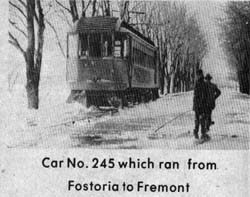
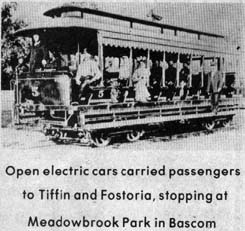

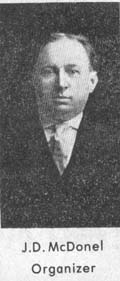
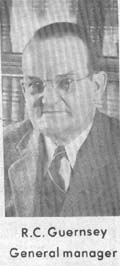
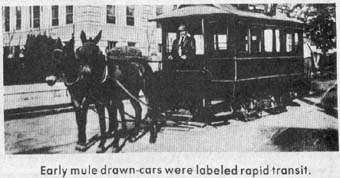
Picture #1 – Car No. 245 which ran from Fostoria to Fremont
Picture #2 – Open electric cars carried passengers to Tiffin and Fostoria, stopping at Meadowbrook Park in Bascom
Picture #3 – Car No. 17 on Toledo, Fostoria, Findlay line Pemberville
Picture #4 – J.D. McDonel – Organizer
Picture #5 – R.C. Guernsey – General Manager
Picture #6 – Early mule drawn cars were labeled rapid transit
EDITORS NOTE: This week’s story is the first in a 3-part installment, pertaining to the days of the electric inter-urbans which served Fostoria and the surrounding area and how they were tied-in with other lines serving Ohio, Indiana and Michigan. The full series contains historical data, photos and interesting and humorous events. All photos used today are through the courtesy of Harry Christiansen, author of “Ohio Trolley Trails.” and appear in his book.
The electric trolley era is only a pleasant memory for those 60 years or older; and for those younger it is a saga to read about in the books, or to listen to when the old-timers spin yarns of the “better days.”
Prior to 1889 there were streetcars – either horse-drawn or electric, in many of the larger cities, but Ohio was the first state in the Union to claim an electric trolley car running between two cities. The place was Newark … the time was Dec. 28, 1889. The new interurban electric line ran from Newark to Granville, a distance of seven miles. The line was called Newark & Granville Electric Street Railway Co.
The folks in Granville, especially the merchants, never wanted the new transportation service, since Newark, the larger town, gained some business because of it. The closing of the Hotel Granville was blamed on the new electric line inasmuch as traveling men could get to Newark easily for overnight accommodations.
By the time 1900 rolled around the interest in electric trolleys as a means of transportation between towns was at its peak. And by the 1930’s the idea was on its way out – because of the severe competition offered by automobiles which were becoming popular and the use of trucks for handling freight.
Fostoria was engulfed in the electric trolley era.
When things were booming it was possible to ride the “red devil” cars, as they were called, to Tiffin, Findlay, Toledo, Fremont and all the small towns in between. And by making connections with other electric trolley lines it was possible to traverse the state of Ohio, as well as Indiana and Michigan.
The Toledo, Fostoria and Findlay Railway Co. (TF&F) was headed by J.E. “Sam” Reeves, president and A.J. Krantz, secretary – treasurer. Reeves and the other principles in the TF&F lived at Canal Dover, Ohio, where he also headed up Reeves Steel & Mfg. Co. (now known as Cyclops Corp). Canal Dover is now known as Dover.
The first leg of the TF&F opened in 1901 and ran between Fostoria and Findlay. In 1905 the line was extended to Pemberville, connecting with the Pemberville Bowling Green line. It was not until 1908 that the final stretch of tracks to Toledo were completed. It was not until 1925 that the TF&F purchased the already existent 14-mile system, Tiffin, Fostoria & Eastern (TF&F). It was an outgrowth of two companies that centered in Tiffin. The original Tiffin & Consolidated Interurban Railway started out with horse-drawn cars and served the town of Tiffin only. Then, the Tiffin & Fostoria Electric R.R. came on the scene in 1898 to provide service between Fostoria and Tiffin.
In the earlier days of the Tiffin line they provided passenger service in a double-decker car said to be the only one in existence anywhere. Open type cars for summer use also operated on the TF&E, and I remember riding them to Meadowbrook Park as a boy.
L.O. “Les” Kisabeth and his sister Ruth resided with their parents on a farm between Fostoria and Bascom when the electric lines were booming. They both rode the cars to Fostoria to attend and graduate from Fostoria High.
Kisabeth tells about the lady passenger who became sick one day while riding the TF&E to Fostoria. When she vomited into the open-ended container in the rest room her dentures flew out and they were found later along the rails.
Harry Christiansen, author of Ohio Trolley Trails, in a letter, reminded me that the Gem Manufacturing Co. at Bascom had a trolley interchange for freight shipments. Gem is still doing business, the rails are still there, where they can be seen crossing the highway and leading into their property. In more recent years the rails were used to run a gasoline locomotive for moving rail cars into their yards.
The Fostoria & Fremont line (F&F) was an outgrowth of the Lima Route; actually a joint Lake Shore Electric (LSE) and Western Ohio (WO) operation. That is a story in itself and will not be explored here except to say that it permitted the owners of the WO to provide faster through service for passengers and freight all the way from western Ohio and Lima to Cleveland by a shorter route than through Toledo.
The F&F line opened in 1911 and lasted until about 1932, when like most of the other electric lines, competition and bad times caused it to cease operation.
When the Nickle Plate railroad started passenger service from Cleveland to Findlay in the late 1920’s it ruined that portion of the business the F&F enjoyed in conjunction with the Lima Route. However, there continued to be service from Fremont through Fostoria to Dayton.
Although the capital for the F&F line came from outside Fostoria, actual building and management was vested in Fostorians. J.D. McDonel, father of Fostorian Lenore McDonel, still living, was the organizer, issued contracts and oversaw the actual building of the line. R.C. Guernsey, father of James D. Guernsey, Fostoria attorney, was the general manager.
Al Bryan, editor of The Fostoria Times, prior to its merger with the The Fostoria Daily Review, recalls when the F&F quit business. In a conversation recently he related: “Curt Guernsey set up a bar in one of the cars that ran between Fostoria and Fremont and offered refreshments to all that rode the line the last day …they had quite a time.”
F&F car No. 40 is still available for inspection by electric car buffs at Trolleyville, U.S.A. Museum in Olmstead Falls, Ohio Harry Christiansen informs me that the car has been painted the original F&F orange. It still has some old inside advertising car cards inside. A large hood has been built over the roof to protect the car until they can complete restoration.
F&F freight car No.159 sits in an auto junkyard in Fremont on Hayes Avenue according to Christiansen…all that remains of the cars that ran on the F&F line.
The old F&F followed the LE&W railroad to Fremont.
Christiansen remarks, “I came across three interesting towns along the steam and electric lines…Amsden, Burgoon and Kansas. Kansas certainly looked like a backdrop in an old western movie. These towns have withered since they were built. An antique shop near the rail crossing in Burgoon has I understand, quite a collection <INCOMPLETE>